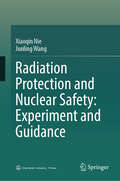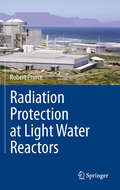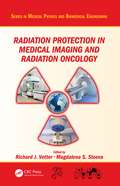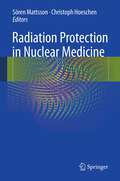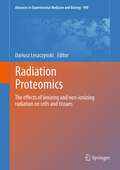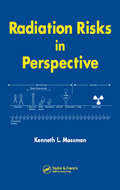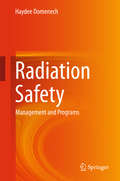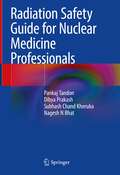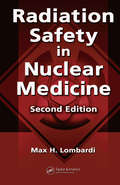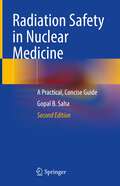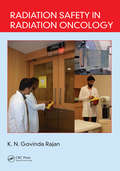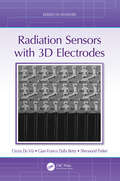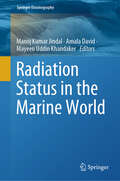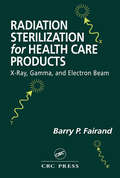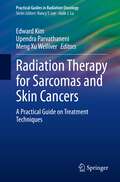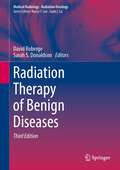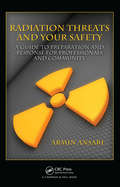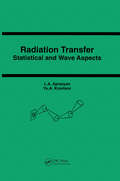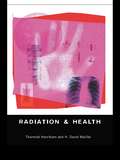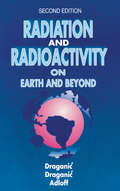- Table View
- List View
Radiation Protection and Nuclear Safety: Experiment and Guidance
by Junling Wang Xiaoqin NieThis book reviews the theory and practice on radiation protection and nuclear safety based on experimental case studies. It concentrates on research advances in radiation detection, radiation monitoring, radioactive waste treatment and disposal. It can both serve as a textbook for advanced undergraduates majoring in radiation protection and nuclear safety, nuclear engineering and technology, nuclear chemical engineering and nuclear fuel engineering and a reference for industry and institutes. The basis of English translation of this book, originally in Chinese, was facilitated by artificial intelligence. The content was later revised by the author for accuracy.
Radiation Protection at Light Water Reactors
by Robert PrinceThis book is aimed at Health Physicists wishing to gain a better understanding of the principles and practices associated with a light water reactor (LWR) radiation protection program. The role of key program elements is presented in sufficient detail to assist practicing radiation protection professionals in improving and strengthening their current program. Details related to daily operation and discipline areas vital to maintaining an effective LWR radiation protection program are presented. Programmatic areas and functions important in preventing, responding to, and minimizing radiological incidents and the importance of performing effective incident evaluations and investigations are described. Elements that are integral in ensuring continuous program improvements are emphasized throughout the text.
Radiation Protection in Medical Imaging and Radiation Oncology (Series in Medical Physics and Biomedical Engineering)
by Richard J. VetterRadiation Protection in Medical Imaging and Radiation Oncology focuses on the professional, operational, and regulatory aspects of radiation protection. Advances in radiation medicine have resulted in new modalities and procedures, some of which have significant potential to cause serious harm. Examples include radiologic procedures that require ve
Radiation Protection in Medical Radiography
by Mary Alice Statkiewicz Sherer Paula J. Visconti E. Russell Ritenour Kelli HaynesRadiation Protection in Medical Radiography, 7th Edition makes it easy to understand both basic and complex concepts in radiation protection, biology, and physics. Concise coverage promotes the safe use of ionizing radiation in all imaging modalities, including the effects of radiation on humans at the cellular and systemic levels, regulatory and advisory limits for human exposure to radiation, and the implementation of radiation safety practices for patients and personnel. This edition includes NEW content on the impact of radiation levels during the nuclear power plant crisis that followed the 2011 earthquake/tsunami in Japan. From an author team led by well-known radiation protection expert Mary Alice Statkiewicz Sherer, this text has consistently helped students perform well on the ARRT exam! Convenient, easy-to-use features include chapter outlines and objectives, highlighting of key terms, and bulleted summaries and review questions to enhance comprehension and retention. Clear and concise writing style covers complex concepts in radiation protection, biology, and physics in a building-block approach from basic to more complex concepts. Review questions are included at the end of chapters to assess your comprehension, with answers on the Evolve companion website. Coverage of historical radiological disasters includes photos and text on Hiroshoma, Chernobyl, and Three-Mile Island. UPDATED! NCRP and ICRP content includes guidelines, regulations, and radiation quantities and units, explaining the effects of low-level ionizing radiation, demonstrating the link between radiation and cancer and other diseases, and providing the regulatory perspective needed for practice. NEW! Discussion of Total Effective Dose Equivalent (TEDE) covers the radiation dosimetry quantity defined by the U. S. Nuclear Regulatory Commission to monitor and control human exposure to ionizing radiation.
Radiation Protection in Nuclear Medicine
by Christoph Hoeschen Sören MattssonThis book explains clearly and in detail all aspects of radiation protection in nuclear medicine, including measurement quantities and units, detectors and dosimeters, and radiation biology. Discussion of radiation doses to patients and to embryos, fetuses, and children forms a central part of the book. Phantom models, biokinetic models, calculations, and software solutions are all considered, and a further chapter is devoted to quality assurance and reference levels. Occupational exposure also receives detailed attention. Exposure resulting from the production, labeling, and injection of radiopharmaceuticals and from contact with patients is discussed and shielding calculations are explained. The book closes by considering exposure of the public and summarizing the "rules of thumb" for radiation protection in nuclear medicine. This is an ideal textbook for students and a ready source of useful information for nuclear medicine specialists and medical physics experts.
Radiation Protection: A Guide for Scientists, Regulators, and Physicians, Fourth Edition
by Jacob ShapiroThis highly successful manual has served for nearly three decades as the definitive guide to the safe use of radioactive materials. Completely revised and updated, the fourth edition presents a new dimension by adding coverage of nonionizing radiation, and is thus concerned with the entire field of radiation protection. The author takes the novel approach of introducing the whole range of energies possessed by particles and electromagnetic waves at the beginning of the text, thus integrating coverage of ionizing and nonionizing radiation rather than considering them as two separate disciplines. He goes on to cover the entire spectrum of radiation sources, including radionuclides, x-ray machines, accelerators, nuclear reactors, power lines, microwave towers, and cellular phones. With its expanded coverage, including a broader focus on public health issues, this new volume will serve as an important training and reference resource, not only for research scientists, physicians, and engineers, but for regulatory officials, attorneys, engineers, and environmental health and safety professionals. The breadth of citations alone makes this resource invaluable.
Radiation Proteomics
by Dariusz LeszczynskiMethods of proteomics have been shown to be powerful tools in search of target proteins - proteins that respond in cells to an internal or an external stimulus. Proteomics is widely used in biomedical research. However, in radiation biology research, following exposures of living matter to low doses of either ionizing or non-ionizing radiation, proteomics approach is only very slowly gaining support. This book, by presenting the current status of the use of proteomics in radiation biology, will help to attract attention to the field of radiation proteomics.
Radiation Risks in Perspective
by Kenneth L. MossmanPublic misperception of radiological risk consistently directs limited resources toward managing minimal or even phantom risks at great cost to government and industry with no measurable benefit to overall public health. The public's inability to comprehend small theoretical risks arrived at through inherently uncertain formulae, coupled with an ir
Radiation Safety
by Haydee DomenechThis book discusses important fundamentals of radiation safety with specific details on dose units, calculations, measuring, and biological effects of ionizing radiation. The author covers different exposure situations and their requirements, and relevant legislation and regulations governing radiation safety. The book also examines radioactive waste management, the transport of radioactive materials, emergency planning and preparedness and various examples of radiation protection programs for industrial, medical, and academic applications.
Radiation Safety Guide for Nuclear Medicine Professionals
by Dibya Prakash Pankaj Tandon Subhash Chand Kheruka Nagesh N BhatThe book covers all the radiation safety aspects while working with unsealed radionuclides. Radiation safety plays a significant role in routine nuclear medicine practices and is necessary to protect occupational workers, patients, members of the general public and the environment. A fair knowledge of radiation safety is expected from all nuclear medicine professionals. Chapters include basics of radiation physics, biological bases of radiation protection, planning and design of nuclear medicine facilities, cyclotron and high dose therapy facilities, radiation safety considerations in nuclear medicine, cyclotron while preparing radiopharmaceuticals. It also includes the working mechanism of radiation detectors, quality assurance of positron emission tomography (PET) and gamma camera, including single photon emission computed tomography (SPECT), emergency preparedness plan, nuclear medicine and CT dosimetry, transport regulations, the role of national regulatory authorities and radioactive waste management. The last chapter provides probable model questions asked in the radiological safety officer certification examination and includes 250 multiple-choice questions (MCQs), 100 true or false, 60 fill in the blanks, and 40 match the following questions. The book is written in a simple language for a better understanding of the occupational workers of any grade. It serves as reference material for nuclear medicine professionals on radiation safety, related to planning, quality assurance, dosimetry and various regulations pertaining to nuclear medicine. It is a ready reckoner for the students pursuing a degree/diploma in nuclear medicine and preparing for certification courses in radiation safety to understand the subject matter along with options to attempt practice questions.
Radiation Safety in Nuclear Medicine
by Max H. Lombardi Allen Cato III Lynda SuttonRecent advances in the field of nuclear medicine (NM) are expanding the role and responsibilities of the nuclear medicine technologist (NMT) to include more complex and detailed tasks. New technologies are making the diagnosis, management, and treatment of illnesses more sensitive, more specific, more accurate, and ultimately safer for both the pat
Radiation Safety in Nuclear Medicine: A Practical, Concise Guide
by Gopal B. SahaThis book is a collection of all pertinent information on radiation safety applicable in nuclear medicine and research using radioactive materials. Radiation exposure causes harm to humans and is strictly controlled by several regulatory authorities (NRC, FDA, EPA, DOT, etc). The practice of nuclear medicine involves the use of radioactive materials in patients and research, and is well regulated by these agencies. However, information on radiation safety practice in nuclear medicine and research areas is scattered throughout the literature and federal registers. For busy nuclear technologists and professionals, it is quite time consuming to look for and acquire specific information and instructions to follow in radiation-related occasions and incidents. This guide provides ready-made, handy information on radiation safety as required in the practice of nuclear medicine, presented in a concise form for easy understanding and quick reference related to a given situation and/or incident. This is an ideal reference for nuclear medicine physicians, nuclear medicine technologists, and researchers using radioactive materials.
Radiation Safety in Nuclear Medicine: A Practical, Concise Guide
by Gopal B. SahaThis new edition is a fully updated guide to radiation safety practice for nuclear medicine professionals, and assists the nuclear medicine technologists in taking their board certifying examination. The NRC requires the appointment of a radiation safety officer (RSO) or an associate radiation safety officer (ARSO) for different uses of radioactive material. Board certified nuclear medicine technologists are eligible to be RSO and ARSO in specific uses of radioactive material after successfully completing a 40-hr or 200-hr course on radiation safety depending on the type of RAM use. This book covers all subject materials in these courses on radiation safety. This guide provides ready-made, handy information on radiation safety as required in the practice of nuclear medicine, presented in a concise form for easy understanding and quick reference related to a given situation and/or incident. The major change in the new edition of the book is the addition of questions at the end of each chapter, to ensure the comprehension of the material by the examinees taking their certifying board examinations. As mentioned in the first edition, the NRC 10CFR20 for Standards for Radiation Protection and the NRC 10CFR35 for Medical Uses of Radioactive Materials are the primary sources of practical information on radiation safety in nuclear medicine. Much of the information is still valid, but many changes and additions have also been made since, which are fully updated here. This is an ideal reference for nuclear medicine physicians, nuclear medicine technologists, and researchers using radioactive materials.
Radiation Safety in Radiation Oncology
by K. N. Govinda RajanThe proposed book aims to explain the basic principles, concepts and regulations behind radiation protection and their application in the field of radiation oncology practice. This book will be useful to all those students, teachers and practicing professionals involved in the field of radiation oncology.
Radiation Sensors with 3D Electrodes (Series in Sensors)
by Sherwood Parker Cinzia Da Vià Gian-Franco Dalla BettaWritten by the leading names in this field, this book introduces the technical properties, design and fabrication details, measurement results, and applications of three-dimensional silicon radiation sensors. Such devices are currently used in the ATLAS experiment at the European Centre for Particle Physics (CERN) for particle tracking in high energy physics. These sensors are the radiation hardest devices ever fabricated and have applications in ground-breaking research in neutron detection, medical dosimetry and space technologies and more. Chapters explore the essential features of silicon particle detectors, interactions of radiation with matter, radiation damage effects, and micro-fabrication, in addition to a providing historical overview of the field. This book will be a key reference for students and researchers working with sensor technologies. Features: The first book dedicated to this unique and growing subject area, which is also widely applicable in high-energy physics, medical physics, space science and beyond Authored by Sherwood Parker, the inventor of the concept of 3D detectors; Cinzia Da Vià, who has brought 3DSi technology to application; and Gian-Franco Dalla Betta, a leading figure in the design and fabrication technology of these devices Explains to non-experts the essential features of silicon particle detectors, interactions of radiation with matter, radiation damage effects, and micro-fabrication
Radiation Status in the Marine World (Springer Oceanography)
by Manoj Kumar Jindal Amala David Mayeen Uddin KhandakerNatural radiation is omnipresent everywhere on the earth, and humans cannot avoid it. Natural radiation is a critical aspect in understanding the health issue and predicting the existence of radionuclides. Because the ocean is the source of all materials, and due to the fact that water from everywhere is submerged in the ocean through river networks, the ocean will contain varying radiation doses in every site. This book has information about radiation status near the ocean in all areas on Earth. There are five oceans, namely: the Atlantic, Pacific, Indian, Arctic, and Antarctic Oceans. This book is a valuable resource of its kind for indicating the radiation status in all types of oceans. The outcomes of this book are extremely valuable to people in a variety of fields, including health sciences, material sciences, radiological fields, environmental science, oceanology, water world, and so on.
Radiation Sterilization for Health Care Products: X-Ray, Gamma, and Electron Beam
by Barry P. FairandFocusing on how the radiation process works and how it is applied in sterilizing medical devices and healthcare products, Radiation Sterilization for Health Care Products covers recent developments in radiation technology such as e-beams, gamma rays, and x-rays. The author discusses the design and operation of irradiators as well as factors that affect cost and efficiency. He offers readers practical insights on this critical step in healthcare product manufacturing, its current uses, and its related cost concerns. Authortitative and comprehensive, the book brings togehter information scattered throughout the literature into one convenient resource.
Radiation Synthesis of Materials and Compounds
by Boris I. Kharisov Oxana V. Kharissova Ubaldo Ortiz MéndezResearchers and engineers working in nuclear laboratories, nuclear electric plants, and elsewhere in the radiochemical industries need a comprehensive handbook describing all possible radiation-chemistry interactions between irradiation and materials, the preparation of materials under distinct radiation types, the possibility of damage of material
Radiation Therapy for Sarcomas and Skin Cancers: A Practical Guide on Treatment Techniques (Practical Guides in Radiation Oncology)
by Edward Kim Upendra Parvathaneni Meng Xu WelliverThis practical guide to the use of radiotherapy for the treatment of sarcomas and skin cancers covers a wide range of disease scenarios, identifying which treatment techniques are applicable in particular clinical circumstances. Among the conditions considered are extremity soft tissue sarcomas, retroperitoneal soft tissue sarcomas, bone sarcomas, uterine sarcomas, chordomas, pediatric sarcomas, squamous cell carcinomas, basal cell carcinomas, melanomas, Merkel cell carcinomas, and cutaneous lymphomas. Detailed attention is devoted to the issues and considerations of relevance in everyday practice when treating these diseases. The use of multiple radiotherapy techniques and procedures, including IMRT, brachytherapy, radiosurgery, and particle therapy, is fully explained, and the role of radiotherapy in combination with chemotherapy and emerging therapeutics such as immunotherapy and biologic anticancer agents is also addressed. The book will be of high value for practicing radiation oncologists, medical and surgical oncologists, medical physicists, medical dosimetrists, trainees, and other medical professionals.
Radiation Therapy of Benign Diseases (Medical Radiology)
by Sarah S. Donaldson David RobergeThis expanded and updated second edition is a practical text to aid radiation oncologists in evaluating and treating benign diseases. An introductory chapter by an eminent malpractice lawyer clarifies the medical-legal implications of the radiation treatment of such diseases, and this is followed by the various benign conditions in alphabetical order. In each case, a brief summary is followed by citations of pertinent literature in both explanatory tables and reference lists. Although a comprehensive review, it remains readily comprehensible and will be recognised as the standard text on the subject.
Radiation Threats and Your Safety: A Guide to Preparation and Response for Professionals and Community
by Armin AnsariWhile it has aided far many more than it has harmed, radiation is forever etched in the public's mind as an indiscriminate and particularly pernicious killer. Consequently, it is especially critical in this age of terrorist threats that we equip ourselves with accurate information and practical tools that will serve us in the rare chance that we find ourselves in a radiation crisis.Radiation Threats and Your Safety: A Guide to Preparation and Response for Professionals and Community offers a calm and authoritative approach to crisis preparation. Written by a health physicist from the U.S. Centers for Disease Control and Prevention, the book informs us about what we should know ahead of time, how to prepare, and the best ways to respond to a nuclear or radiological incident either as an emergency responder or community/family member. Organized to serve both as a preparation guide and as a reference in a crisis, this book -Uses common language while avoiding unnecessary scientific jargon -Details protocols for both accidental and intentional radiation emergencies such as nuclear explosions and dirty bombs-Shows how to prepare a family emergency plan-Covers medical responses to radiation emergencies including radiation drugs -Provides an emergency supply list -Discusses radiation from microwaves and cellular phones as well as food irradiation There is no reason why we should feel helpless when faced with a radiation emergency. We can take action to protect ourselves, our families, and our communities. How we react to a radiation emergency will determine its true final impact. To this end, we need information and leaders we can depend upon.
Radiation Transfer
by L. A. Apresyan Yu. A KravtsovThe authors expound on non-traditional phenomena for transfer theory, which are nevertheless of considerable interest in wave measurements, and bring the advances of transfer theory as close as possible to the practical needs of those working in all areas of wave physics. The book opens with a historical overview of the topic, then moves on to examine the phenomenological theory of radiative transport, blending traditional theory with original ideas. The transport equation is derived from first principles, and the ensuing discussion of the diffraction content of the transport equation and non-classical radiometry is illustrated by practical examples from various fields of physics. Popular techniques of solving the transport equation are discussed, paying particular attention to wave physics and computing the coherence function. The book also examines various problems which are no longer covered by the traditional radiative transfer theory, such as enhanced backscattering and weak localization phenomena, nonlinear transport problems and kinetic equations for waves. This monograph bridges the gap between the simple power balance description in radiative transfer theory and modern coherence theory. It will be of interest to researchers and professionals working across a wide range of fields from optics, acoustics and radar theory to astrophysics, radioastronomy and remote sensing, as well as to students in these areas.
Radiation and Health
by Thormod Henriksen David H. MaillieRadiation and the effects of radioactivity have been known for more than 100 years. International research spanning this period has yielded a great deal of information about radiation and its biological effects and this activity has resulted in the discovery of many applications in medicine and industry including cancer therapy, medical diagnostics
Radiation and Radioactivity on Earth and Beyond
by Jean-Pierre Adloff Ivan G. DraganicThis book features information regarding the Chernobyl nuclear accident, the production of elementary particles, radiation exposure, the geopolitical effects of the end of the nuclear arms race between the U.S. and the former Soviet Union, and the future of nuclear power.
Radiation and the International Space Station: Recommendations to Reduce Risk
by Committee on Solar Space PhysicsA risk report on Radiation and the International Space Station
